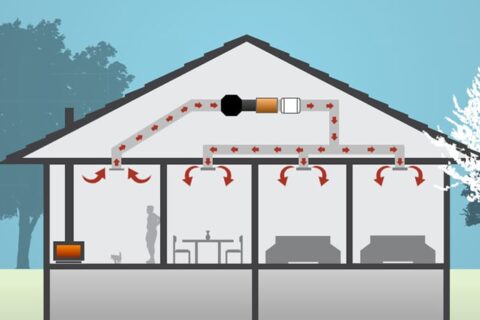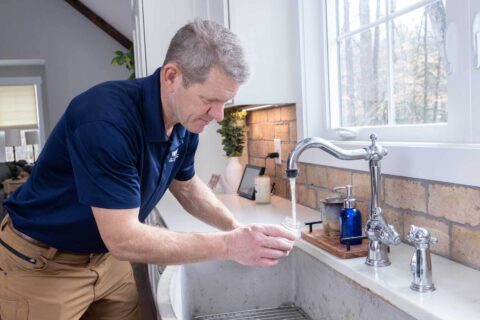5 Essential Air Quality Solutions for Your Home Office
Key Takeaways
-
IEQ significantly influences our health, comfort, and productivity. This is particularly true for home offices, where we now work for extended periods of time.
-
Common indoor pollutants such as VOCs, dust, and mold pose a significant risk to IAQ. This can lead to acute health effects and raise chronic respiratory disease risk over the long-term.
-
Poor air quality has been shown to decrease cognitive function, increase fatigue and stress which collectively can lower both work productivity and general health.
-
Effective solutions to improve IAQ include using air purifiers, increasing ventilation, controlling humidity, incorporating air-purifying plants, and maintaining cleanliness in the workspace.
-
When you customize air quality solutions to your home office requirements, you’ll make them more effective and convenient. For optimal results, choose based on available space and pollutants present.
-
Improved IAQ leads to better health, heightened cognitive function, and improved mood and morale, resulting in a healthier, happier, and more productive workforce.
Developing a comfortable home office is about more than just getting the right furniture and lighting. Air quality is one of the most important factors to productivity and employee well-being. As air pollution and allergens are making their way indoors, discovering the most effective air quality solutions guarantees a healthier workplace.
High-efficiency particulate air (HEPA) filters are great for trapping dust, pollen, and mold. Portable air purifiers easily scale to various sizes and spaces. Adding indoor plants such as snake plants or peace lilies can lower carbon dioxide levels and increase air circulation.
Ventilation systems paired with smart controls ensure consistent fresh airflow all day long. All of these options aid in focus, minimize fatigue, and create a better state of health. By focusing on air quality, home offices can be made into environments that facilitate productive, healthy, and lasting comfort to tackle the demands of daily work.
What Is Indoor Air Quality
Definition of Indoor Air Quality
Indoor air quality (IAQ) refers to the quality of air in an indoor environment. It is concerned with indoor air quality, including its impact on human health and occupants’ comfort. What that air quality looks like is impacted by things such as ventilation efficiency, humidity, and whether or not pollutants are present.
For example, lack of ventilation can cause dangerous pollutants to build up, and high humidity can increase the risk of mold. IAQ plays a vital part in making both our built and natural environments healthy. That helps make sure the air we breathe at home and work supports our health and productivity.
Why Indoor Air Quality Matters
IAQ is an important factor in public health. High levels of pollution indoors can cause fatigue, headaches, or respiratory problems, and in extreme cases, lung cancer. For employees continuing to work remotely, high IAQ improves cognitive performance, aiding in concentration and decision-making.
It further supports emotional well-being, since clean air fosters a comfortable, stress-free environment. Keeping indoor air quality as high as possible reduces the number of sick days. It establishes a better work-life balance, allowing you to more easily juggle extended hours.
Common Pollutants in Home Offices
Home offices have the potential to release harmful pollutants, including volatile organic compounds (VOCs) released from paints, office furniture, and cleaning products. They can be home to dust mites and pet dander. Mold, which is sometimes easily seen as dark spots on walls or ceilings, loves wet environments and worsens IAQ.
Common activities, like cooking or using a wickless candle, can introduce hazards like carbon monoxide or fine particles into the air. Even pesticides, which are commonly tracked indoors, can stick around in the air. These considerations point to the need for a more proactive approach to tackling IAQ.
Effects of Poor Air Quality
Health risks of poor air quality
Inadequate indoor air quality (IAQ) can pose short- and long-term health risks. Inhaling airborne pollutants can initiate new respiratory disorders such as asthma or exacerbate future ailments or aggravate current ailments like allergies. According to the Environmental Protection Agency (EPA), secondhand smoke triggers asthma attacks in up to 1,000,000 children annually. As a result, these children have more trouble breathing.
Long-term exposure to pollutants such as mold spores or dust mites can lead to coughing, wheezing, and even migraines. The dangers of long-term exposure to poor IAQ are even graver. The health effects of radon, among other pollutants, can be severe. The EPA links radon exposure to 21,000 lung cancer deaths in the U.S. Annually and considers it a factor in chronic respiratory diseases.
Lead air pollution, even at levels considered low, is known to disrupt mental and physical development, especially in children. This is especially important as Americans now spend 90% of their time indoors, increasing the risk of long-term exposure. Our mental health takes a hit in polluted environments. High levels of air pollution can raise stress levels, thus exacerbating anxiety, depression, and diminishing quality of life.
For home workers, this means not only physical, but emotional burden as well.
Impact on productivity and focus
Polluted air has far-reaching impacts beyond health. Tiredness and trouble focusing are notable in the poorly ventilated environment. For example, air pollutants such as carbon dioxide and fine particulate matter can reduce cognitive function, leading to greater work error rates.
With home offices now the norm, this can have an immediate impact on productivity and morale. High-quality air, on the other hand, decreases stress and increases concentration, improving efficiency and enjoyment in even the most mundane tasks.
Long-term consequences for home workers
Long-term exposure to indoor air contaminants can increase the risk of developing chronic conditions such as COPD or other respiratory diseases. Chemicals from cleaning products or pesticides, often stored within reach of children, can accumulate over time, creating long-lasting health issues.
Proactive measures, including improved ventilation and use of air purifiers, protect against these dangers and foster greater long-term health.

How to Improve Air Quality
To create an overall healthier home office, begin with simple measures to reduce indoor air pollution and improve IAQ. When you stack strategies, you can go beyond targeting just pollutant sources or just ventilation or just air cleaning to deliver comprehensive control.
Here are some of the top solutions to inspire you to create a cleaner and more productive workspace.
1. Use Air Purifiers Effectively
Air purifiers are great for filtering out targeted pollutants. If you are purchasing one, look for units that have a Clean Air Delivery Rate (CADR) and select one that fits your room size.
For instance, if your office is sensitive to pet dander, find air purifiers with HEPA filter technology. Position them close to sources of pollutants, or in the middle of the room for even airflow.
For best performance, clean or replace filters every three to six months, depending on usage.
2. Increase Natural Ventilation
Crack a window or open a door from time to time to introduce fresh air. Fans can improve air movement and ventilation in spaces that don’t have adequate or any ventilation.
For optimum air exchange, establish cross-ventilation by opening windows on opposite sides of the space. This easy action goes a long way to eliminate harmful indoor pollutants and allow cleaner outdoor air to enter your home.
3. Control Humidity Levels
Maintaining a humidity level of 30 to 50 percent makes it difficult for mold and dust mites to thrive. Consider using a dehumidifier in particularly damp areas and check humidity levels with a hygrometer.
This balance, though delicate, is necessary for a productive, comfortable, and healthy workspace.
4. Add Indoor Plants for Air Cleaning
Plants such as peace lilies, spider plants, and snake plants remove airborne toxins and release oxygen into the air. Position them near where you spend the most time to maximize their aesthetic and air-purifying benefits.
Then there are the mood-boosting, stress-reducing benefits of plants, which go beyond improving air quality.
5. Reduce Sources of Indoor Pollution
Reduce VOCs by avoiding VOCs through the use of low-VOC paints and cleaning supplies. Keep pets out to lower allergens such as dander.
Dust accumulates on every surface, so declutter often to keep dust from clogging air vents and making surfaces dirtier.
6. Regularly Clean and Maintain the Space
Clean as often as you can to get rid of allergens and dust. If you have carpets, consider using HEPA vacuum cleaners on carpets and hard floors.
Keep vents open and unobstructed to help air flow freely. Implement a vigorous, in-house cleaning regimen on a weekly basis to ensure that the office always looks and feels fresh.
Tips for Choosing Air Quality Solutions
Evaluate the size of your home office
Knowing the size of your home office is a great start to selecting the best air quality solutions. Begin by taking an accurate measurement of the square footage of your work area. Most air purifiers will specify the square footage they can handle.
To find the perfect pair for your office, it’s important to understand what size space your office is. Finally, consider the arrangement. A large corner desk may limit airflow in your room. For best circulation, it’s usually ideal to place a purifier closer to the center of the room.
Larger spaces usually benefit with the implementation of multiple solutions. Pair a purifier with indoor plants such as peace lilies to improve air quality even further. Combined, they’ll tackle virtually all of your space.
Identify specific air quality issues
So, it’s crucial to identify the pollutants you have in your office. Dust, pet dander, or even mold that collects inside can hurt air quality. An air quality test kit, preferably one that is certified by the EPA, can help you spot these problems.
If you are concerned about odors, step outside for a few minutes. When you return inside, notice what odors hit your nose first. Personal sensitivities such as allergies or asthma due to dust can need allergen-proof encasements for furniture and hot water washing of bedding to control pests.
Consider energy efficiency and cost
Smart, energy-efficient solutions—such as Energy Star-certified air purifiers—help save utility bills while helping save lives. Though better systems will initially be more expensive, they tend to have longer lifespans and need less future repair work.
Weigh these costs against maintenance you’ll be responsible for on an ongoing basis, like filter replacements, to ensure you’re making an intelligent decision.
Opt for low-maintenance solutions
Low-maintenance indoor air quality solutions, such as air purifiers with filter replacement indicators or self-cleaning functions, will save you time. Automated indoor air quality monitors that calibrate based on the air quality level reduce daily annoyances, making them perfect for on-the-go professionals.
Benefits of Improved Air Quality
The rewards of developing a home office with optimal IAQ are immense. Clean air has a profound effect on our mental acuity and emotional poise. It’s more than just breathing easier — it’s improving the overall work-from-home experience. By producing a healthier environment, we’re able to cut sick days, keep up productivity over the long haul, and build long-term wellness.
Here’s a quick look at how improved air quality helps.
Enhanced health and well-being
Clean air means less exposure to irritants like dust, allergens, and other pollutants, which means fewer respiratory problems and allergy flare-ups. That’s more breathing easy, less coughing, sneezing and irritation, keeping you healthier year-round.
For one thing, cleaner air leads to improved sleep, which is vital for keeping a good mood and energy levels. Nature and fresh air do wonders to relieve stress and create a more peaceful state of mind. This has the added benefit of extending it to everyone in the household.
By investing in air quality solutions, you make your workspace a healthy place to be. This tangible improvement means healthier homes for you and your family.
Boosted productivity and focus
Air pollution affects cognitive function and productivity. It’s not just workplace productivity—research has shown that improved IAQ can boost cognitive function by an astounding 61%, with even greater improvements when ventilation is improved.
That does make a difference—increased attention span, faster decision-making, stronger analytical problem-solving abilities. Improved air quality increases worker productivity by 8%, which amounts to an increase of $6,500 in annual productivity value per worker.
Remote workers consistently experience the greatest job satisfaction levels in clean-air settings, further underscoring the need for IAQ to thrive in order for professionals to succeed.
Better comfort in the home office
An environment with clean air is simply more fresh and inviting—a stimulating space that inspires creativity and productivity. Comfort is important when you’re spending eight hours at your desk, and a healthy environment can help you stay focused for a longer stretch.
Each piece plays into creating a space that fosters an organic flow of ideas. It supports odor removal and provides a constant source of fresh, circulating air, helping to reduce stress and anxiety.
Key benefits at a glance:
-
Fewer respiratory issues and better overall health
-
Enhanced mood, reduced stress, and improved sleep
-
Increased productivity and cognitive performance
-
More comfortable and inspiring work environment
-
Fewer sick days and higher job satisfaction
Conclusion
Improving air quality in your home office helps create a healthier, more productive workspace. Improved air quality helps maintain concentration, increases vigor, and lowers exposure to allergens or other irritants. Even small interventions, such as introducing air purifiers, utilizing plants, or selecting low-VOC materials can have a significant impact. These changes go beyond creating a comfortable work environment. After all, they affect you personally and affect how you perform day-to-day.
To begin with, choose one solution that works best for your budget and available space. Whether that means upgrading your ventilation systems or investing in a quality air purifier, every step makes a difference. Breathing better air—making our environments healthier—means working better, living better.
Get involved today and help make a change! Design your environment to work in your favor—not against it. Your lungs and mind, and thus your whole body will thank you.
Frequently Asked Questions
What is indoor air quality?
Indoor air quality refers to the state of air in your residential or work environment and is influenced by surrounding air quality, ventilation, and humidity. Poor air quality indoors has been linked to negative health effects, including respiratory illnesses and allergies, highlighting the importance of indoor air quality solutions for overall wellbeing and productivity.
How does poor air quality affect productivity in a home office?
Creativity and productivity are directly influenced by indoor air quality solutions, as poor air quality can lead to fatigue, headaches, and impaired concentration. Such indoor air quality issues significantly detract from productivity and focus. Maintaining good air quality in your home office is essential for staying energized and performing at your best.
What are the best ways to improve indoor air quality?
Simple methods such as using quality air purifiers, increasing ventilation through a proper building ventilation system, and keeping indoor humidity in check can significantly improve indoor air quality solutions.
How do I choose the right air purifier for my home office?
Pay attention to the room size, filter type (such as HEPA air filters), and noise level when selecting an indoor air quality solution. Choose an air purifier designed to capture indoor air pollutants like dust, allergens, and VOCs, ensuring good air quality while saving on electricity.
What are VOCs, and why should I remove them?
VOCs (volatile organic compounds) are toxic chemicals emitted by paints, cleaning products, and furniture that can cause serious health impacts, contributing to indoor air quality issues. Utilizing quality air purifiers and opting for low-VOC products can significantly mitigate these risks.
Does better indoor air quality improve health?
Yes, better air quality means fewer allergy symptoms, better respiratory health, and more energy. It encourages deeper, more restorative sleep, improved focus, and greater well-being — particularly in stuffy environments such as home offices.
How can I monitor indoor air quality?
Consider utilizing indoor air quality monitors that can help you monitor indoor pollutants, humidity, and temperature levels. These indoor air quality solutions provide real-time feedback, making it easier to spot and solve indoor air quality issues.


